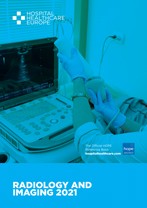Lung ultrasonography is portable and easy to use and has become the ‘go to’ imaging modality for lung and pleura and is recognised as being able to make a substantial contribution to the care of patients with COVID-19.
While computer tomography (CT) has become the mainstay of diagnostic imaging evaluation of thoracic disorders, in the hands of an experienced radiologist, lung ultrasonography has much to offer according to guidance issued by the European Radiology Society (ERS).
Within an intensive care setting, for example, point-of-care ultrasonography enables direct, bedside examination of the lung and pleural space and has been found to reduce the need for chest radiographs and CT scans. Although the standard of care within an intensive care unit is the chest X-ray, in an assessment of the comparative diagnostic performance of auscultation, chest radiography and lung ultrasonography, the latter was deemed to be highly sensitive, specific and reproducible for diagnosing the main lung pathologic entities in patients with acute respiratory distress syndrome (ARDS), which is a recognised complication of infection with COVID-19. More recently, compared with X-rays and CT scans, point-of-care ultrasound of the lungs of patients with COVID-19 has been found to offer similar performance to CT and superior to X-ray, in evaluating pneumonia and ARDS. In fact, the authors of this latter study commented on how lung ultrasound played an important role within the emergency room and intensive care unit, reducing exposure to radiation and minimised transport of high-risk patients.
With the potential benefits of ultrasonography clearly defined, the ERS has released, what it hopes, will be the definitive guide on the role of lung ultrasound in patients with COVID-19. The guidance covers the fundamentals of ultrasonography examinations, the different types of available transducers, including appropriate methods of cleaning and system set-up and concludes with advice on how to perform a lung examination and examples of the typical findings seen in patients with COVID-19.
The guidance defines how when using ultrasound for the diagnosis of lung pathologies, the presence of two artefacts can provide invaluable information. In fact, the document provides several illustrative imaging examples. The first, described as “A-lines” are reverberation artefacts triggered by oscillating tissue with an air interface and which can be seen as parallel, repetitive horizontal lines of the pleural surface. This A-profile is shaped by intact (‘dry’) lung parenchyma containing air when it is combined with normal lung sliding. If sliding is absent, however, it is intensely suggestive of a pneumothorax. In contrast, “B-lines” are vertical hyperechoic artefacts and arise from areas of pleural consolidation and are indicative of accumulation of fluid in the pulmonary interstitial space or alveoli. According to the ERS guideline, although one or B lines might be considered as normal, any increase in number or spread in one zone represents severe pulmonary interstitial oedema.
In a discussion of the different transducer devices, e.g., high and low frequency linear, curvilinear devices, the guidance suggests that high-frequency probes will offer a better solution to observe lesions in the pleural line. Nevertheless, it also makes the important point that ultimately, the performance and interpretation of results is not probe-specific. With respect to cleaning, the guidance indicates that though immersion of the probes in a strong disinfectant is desirable, in the longer term, repeated cleaning could damage the probe.
In fact, the recommendation is that the use of advanced cleaning solutions should be discussed with local infection teams and vendors supplying the machine.
The document ends with some general advice on basic lung examination and the typical findings observed in patients with COVID-lung disease. It notes how pleural effusions are uncommon and that these are more likely among those who are critically ill. The guidance records how lung ultrasonography can reveal the typical patterns for interstitial pneumonia, which in COVID-19 is mainly seen in the peripheral pulmonary zones.
Finally, the guidance notes that while CT may be needed for follow-up of cases in which ultrasonography is unable to provide a specific answer, the portability of the imaging modality avoids the need to transport high-risk patients while at the same time, can provide a prompt and accurate evaluation of the severity of COVID-19 pneumonia as well as permitting tracking of the disease during follow-up.
Citation
European Society of Radiology. The role of lung ultrasound in COVID-19 disease. Insights Imaging 2021. https://doi.org/10.1186/s13244-021-01013-6





